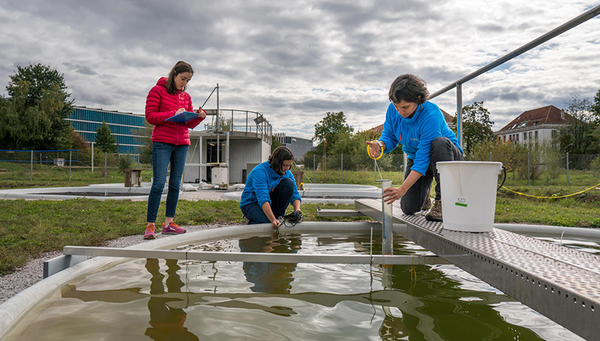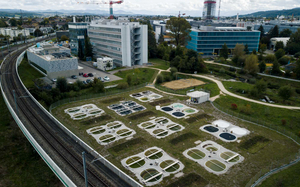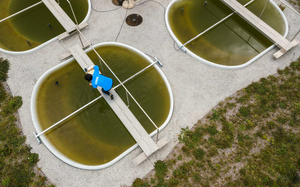Archive detail
Important species interactions can destabilize aquatic ecosystems in response to nutrient inputs
October 16, 2019 |
Ecosystems provide numerous benefits, supplying food, clean water and other resources. So, it is vital that ecosystem stability is maintained in the face of disturbances such as drought, heatwaves or nutrient inputs.
Nutrient inputs can be particularly problematic in aquatic ecosystems if they lead to algal blooms. Excessive algal growth in aquatic ecosystems impairs drinking water quality and algal decomposition causes oxygen depletion. Cyanobacterial blooms can also pose health risks for swimmers and can have lethal effects on aquatic organisms such as water fleas when they produce toxins.
In a recent paper in Proceedings of the Royal Society B, a collaborative and interdisciplinary group of Eawag researchers, led by biologist Anita Narwani, investigated the responses to nutrient inputs at Eawag’s experimental pond facility. They experimentally manipulated twenty artificial whole-pond ecosystems in order to strike a balance between experimental control and ecological realism. The research group investigated how important “foundation species”, such as the invasive freshwater mussel (the “zebra mussel” or Dreissena polymorpha) and a regionally abundant aquatic plant (the “watermilfoil” or Myriophyllum spicatum) can alter the ecology of aquatic ecosystems, and thereby determine how strongly systems are disturbed and how quickly they recover from disturbances.
The twenty experimental ecosystems were inoculated with the natural plankton community from the local Lake Greifen and were then planted either with only the watermilfoil, only the mussels, neither organism or both. Every two weeks, increasing amounts of nutrients (phosphorus and nitrogen) were added to the ponds. There were four ponds that contained neither of the foundation species and did not receive nutrients to track the baseline dynamics.
Unexpected results
After three months, the effects were evaluated: in ponds containing only the mussel or only the watermilfoil, algal growth occurred after the addition of nutrients, but then also rapidly recovered. So, ponds having just one of the two species maintained clearer water overall over the course of the experiment than the ponds that had neither.
Much more surprising, however, according to Anita Narwani, was another observation: in the ponds containing both species together, these results were reversed. In ponds with both species together, the algal biomass and turbidity was significantly higher after nutrient additions than in the ponds with neither, and recovered more slowly as the nutrient inputs got larger. In other words, algal biomass remained persistently high. In addition, in this case, a small cyanobacteria consistently took over and completely dominated these algal blooms, resulting in a loss of taxonomic and trait-level biodiversity. This had knock-on effects on other components of the pond ecosystems, including reduced zooplankton grazer abundances, and higher oxygen concentrations.
How is this to be explained? Narwani says: “The mussels and aquatic plants clear the water, but their effects may have mainly targeted the larger species, including the green algae. We believe that cyanobacteria are more resistant to the grazing by mussels and chemical warfare by the plants, and so their growth increases as the nutrients are added to the system and their competitors are suppressed by the “double whammy” of control by grazers and plants.” This hypothesis was supported by experiments subsequently carried out by Narwani in the laboratory.
She concludes: “Our study confirms that the stability of aquatic ecosystems is strongly influenced by interactions between species.” These findings have important implications for the management of lakes in particular and highlight the disruptive effects on ecosystems that can occur when new species invade. The study also illustrates the advantages of an experimental pond facility, which allows ecological interactions to be investigated in a controlled fashion at a relevant scale for complex natural ecosystems. “We generally cannot run replicated experiments on natural lakes, but we can experimentally manipulate the artificial ponds to better understand natural ecosystem dynamics”, says Narwani.
Original publication
Interactive effects of foundation species on ecosystem functioning and stability in response to disturbance.
http://rspb.royalsocietypublishing.org/lookup/doi/10.1098/rspb.2019.1857
DOI: 10.1098/rspb.2019.1857



